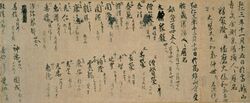Philosophy:Abhiṣeka
Abhiṣeka or abhisheka in Sanskrit means "bathing of the divinity to whom worship is offered."[1] It is a religious rite or method of prayer in which a devotee pours a liquid offering on an image or murti of a God or Goddess. Abhiṣeka is common to Indian religions such as Hinduism, Buddhism and Jainism.
Hinduism
An abhiṣeka is conducted by priests by bathing the image of the deity being worshipped, amidst the chanting of mantras. Usually, offerings such as milk, yogurt, ghee, honey, panchamrita, sesame oil, rose water, sandalwood paste may be poured among other offerings depending on the type of abhishekam being performed. This rite is routinely performed in Hindu temples. A Rudrābhiṣeka or abhiṣeka of Rudra is performed on lingams. A Kumbhabhishekam is a consecration ritual for a Hindu temple.[2]
Buddhism
Esoteric Buddhism
In Vajrayana Buddhism, an abhiṣeka can be a method for performing pointing-out instructions, a way to offer blessings of a lineage to participants, or it can be an empowerment to begin a particular meditation practice.[3] This ritual is present in Tibetan Buddhism as well as in Chinese Esoteric Buddhism and in Shingon Buddhism.
The abhiṣeka was originally used as a consecration rite. Water from the four oceans was poured out of golden jars onto the head of royalty. It was used during a monarch's accession ceremony and also his investiture ceremony.[4]
Tantric Buddhism
The abhiseka rite is a prelude for initiation into mystical teaching. There are four classes of abhiseka, each being associated with one of the four Tantras. They are master consecration, secret consecration, knowledge of prajna, and the fourth consecration.[4]
Shingon Buddhism
The abhiṣeka ritual (灌頂 kanjō) in Shingon Buddhism is the initiation rite used to confirm that a student of esoteric Buddhism has now graduated to a higher level of practice. The kanji used literally mean "pouring from the peak", which poetically describes the process of passing on the master's teachings to the student. The rite was popular in China during the Tang dynasty,[5] and Kūkai, founder of Shingon, studied there extensively before introducing this rite to the Japanese Buddhist establishment of the time.[6] A separate initiation rite exists for the general public called the kechien kanjō (結縁灌頂), and symbolizes their initiation into esoteric Buddhism. This rite is generally only offered at Mount Kōya in Wakayama Prefecture in Japan, but it can be offered under qualified masters and under proper auspices outside Japan, albeit very rarely.[citation needed]
The Shingon rite utilizes one of the two Mandala of the Two Realms, depending on the occasion. In esoteric ritual, after the student receives the samaya precepts, the teacher of the esoteric Buddhism assumes the role of the teacher, usually Mahavairocana Buddha, while the master and student repeat specific mantras in a form of dialogue taken from esoteric Buddhist sutras. The student, who is blindfolded, then throws a flower upon the Mandala that is constructed, and where it lands (i.e. which deity) helps dictate where the student should focus his devotion on the esoteric path.[7] From there, the student's blindfold is removed and a vajra is placed in hand.
Jainism
Abhisheka in Jainism means the ritual of consecration of the image of Jina.[8]
Famous Abhishekas
- Mahaabhishekam conducted at the Mahakaleshwar temple in Ujjain.
- Mahamastakabhisheka at Shravanabelagola in Karnataka.
- Ghanshyam Maharaja [9] abhishekam at Swaminarayan Temple, Godhar, Panchmahal, Gujarat.[10]
Cultural examples
- In the Mahavairocana Sutra, Mahavairocana Buddha reveals the Mandala of the Womb Realm to Vajrasattva and teaches the rites that relate to the Womb Mandala which are known as, and an example of, abhiṣeka.
- In Hinduism, the god Rama performed abhiṣeka after installing a jyotirlinga in Rameswaram.
See also
- Puja
- Rājyābhiṣeka
- Buddhābhiṣeka
- Coronation of the Thai monarch
- Abhi (Sanskrit preposition, and element of the word "Abhisheka")
References
Citations
- ↑ "Monier Williams Online Dictionary". https://www.sanskrit-lexicon.uni-koeln.de/monier/.
- ↑ "Consecration: Kumbhabhishekam | The Pluralism Project". http://pluralism.org/religions/hinduism/the-hindu-experience/consecration-kumbhabhishekam/.
- ↑ Hayward (2008) p.114
- ↑ 4.0 4.1 Hoiberg, Dale H., ed (2010). "abhiseka". Encyclopædia Britannica. I: A-ak Bayes (15th ed.). Chicago, Illinois: Encyclopædia Britannica Inc.. pp. 32. ISBN 978-1-59339-837-8. https://archive.org/details/newencyclopaedia2009ency/page/32.
- ↑ Orzech, Charles, D. (2011). On the Subject of Abhiseka, Pacific World 3rd series, No 13, 113-128
- ↑ Abe, Ryūichi (1999). The Weaving of Mantra: Kūkai and the Construction of Esoteric Buddhist Discourse.
- ↑ Hakeda, Yoshito (1972). Kūkai: Major Works, Translated, with an Account of His Life and a Study of His Thought. pp. 44.
- ↑ Maniura & Shepherd 2006, pp. 73-74.
- ↑ "Ghanshyam Maharaj". http://www.tirthdham.org/abhishek.html.
- ↑ Godhar, Panchmahal, Gujarat
Sources
- Maniura, Robert, ed. (2006), Presence: The Inherence of the Prototype within Images and Other Objects, Ashgate, ISBN 0-7546-3493-0, https://books.google.com/books?id=1x8Tz9v348cC
Further reading
- Authorship unattributed (1993). "Why Temples?". Archived from the original on 2007-06-10. https://web.archive.org/web/20070610190751/http://www.yogamag.net/archives/1993/3may93/temples.shtml. Retrieved 2007-02-24.
- Authorship unattributed (2004). "Healing Through Yagya / Pooja / Occult". Archived from the original on 6 February 2007. https://web.archive.org/web/20070206203633/http://www.mudrasforhealing.com/occult.htm. Retrieved 2007-02-24.
- Abe, Ryuichi (1999). "The Weaving of Mantra: Kukai and the Construction of Esoteric Buddhist Discourse". Columbia University Press. ISBN:0-231-11286-6
- Ferm, Virgilius (1945). An Encyclopedia of Religion. New York: Philosophical Library, 1945. OCLC 263969
- Hakeda, Yoshito S. (1972). Kūkai and His Major Works. Columbia University Press. ISBN:0-231-05933-7
- Hayward, Jeremy (2008) Warrior-King of Shambhala: Remembering Chögyam Trungpa. Boston: Wisdom. ISBN:978-0-86171-546-6


